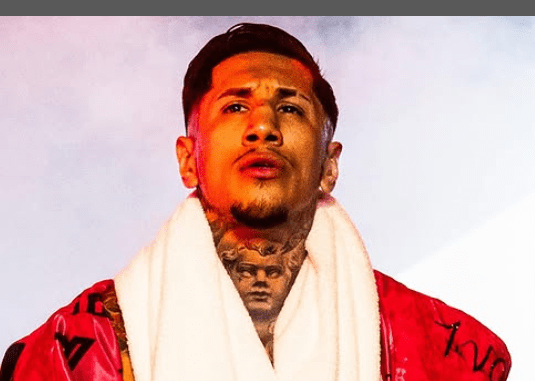The background behind Fernando Vargas’s net worth, which was estimated to be around $500,000 in 2025, is far more complex than the sum indicates. It symbolizes a heritage created in sweaty gyms, reenacted via the lens of a camera, and shown under stadium lights. His financial trajectory is especially remarkable when seen in the context of a boxing period characterized by Shane Mosley’s lightning-fast skill and Oscar De La Hoya’s worldwide supremacy. At least for a moment, Vargas was on equal footing with them all, both monetarily and physically.

Due to necessity and innate ability, he started boxing at the age of twelve. After nine years, he became a professional and immediately attracted notice with a style that combined technical skill and restrained ferocity. He became the youngest person to win the IBF light middleweight title at the age of 21, which is still a very remarkable accomplishment considering the level of competition at the time.
Fernando Vargas – Bio, Career & Financial Overview
| Category | Details |
|---|---|
| Full Name | Fernando Javier Vargas |
| Date of Birth | December 7, 1977 |
| Birthplace | Oxnard, California, United States |
| Nationality | American |
| Height | 5 ft 10 in (178 cm) |
| Reach | 70 in (178 cm) |
| Professional Career | 1997 – 2007 |
| Weight Class | Light Middleweight |
| Major Titles | IBF Light Middleweight, WBA Light Middleweight |
| Net Worth (2025) | $500,000 |
| Spouse | Martha Vargas |
| Children | Fernando Jr., Amado, Emiliano |
| Notable Rivals | Oscar De La Hoya, Shane Mosley, Félix Trinidad |
| Reality TV Appearance | “Welcome to Los Vargas” |
| Reference | celebritynetworth.com/richest-athletes/boxers/fernando-vargas/ |
Vargas took part in high-profile bouts through the early 2000s, which were incredibly profitable by the time’s standards. His earnings per fight were frequently well into six figures, perhaps surpassing the million-dollar mark, thanks to pay-per-view agreements and endorsements. Even though he made a lot of money boxing, his long-term financial plan lacked the kind of diversified asset management that many contemporary boxers use through fitness brands, foundations, or real estate endeavors.
Consider Manny Pacquiao, who became a multimillionaire through his dual career in politics and athletics, or Floyd Mayweather, who established a promotional empire. Vargas, on the other hand, put up a fierce fight but was largely dependent on quick cash. Legal problems, such as a 2001 house detention sentence for an assault incident that occurred in 1999, made that habit very troublesome. His chances of getting an endorsement were greatly diminished by the legal fees and reputational harm.
In addition to being a financial high, his fight with Oscar De La Hoya in 2002 marked a sea change. After the fight, Vargas tested positive for steroids, which further hurt his chances of making money. The stain persisted despite his insistence that the outcome was caused by an injection he was unaware was unlawful. After that, there were fewer well-known names in line, and by 2007, he had left the ring.
There was a phase of reinvention that followed. Vargas made a wise, if modest, turnabout, in contrast to some former athletes who slip into obscurity or plunge into financial ruin. Welcome to Los Vargas, a family-oriented reality TV program, gave viewers a close-up look at his life as a husband and father of three boys, all of whom are boxing professionals. His brand was repositioned with remarkable success thanks to this move. It enabled Vargas to fund his sons’ nascent careers while maintaining cultural relevance.
The Vargas boys have gained notoriety fast, particularly Fernando Jr. With 12 knockouts and an undefeated record of 13-0, the younger Vargas is undoubtedly carrying on the family tradition. Not far behind, Amado and Emiliano exhibit a methodical approach and polished technique that are clearly impacted by their father’s instruction and guidance. Fernando Vargas Sr. may see his net worth steadily increasing once more as a result of his sons’ accomplishments—not via personal bouts, but rather through earnings as a manager, trainer, and public figure associated with the upcoming boxing generation.
Digital media and technology have changed boxing in recent years. Without the help of traditional media, athletes like Ryan Garcia and Gervonta Davis have become quite popular on Instagram and TikTok, commanding large followings. Vargas’s charisma, energy, and spirit of perseverance would have probably made him a sensation on digital platforms if he had come up in this day and age, turning followers into fans and fans into business chances. The difference between the two periods is especially illuminating; Vargas’s time was centered on television viewership and in-person ticket sales, whereas modern boxers make money off of each tweet, stream, and post.
Legacy families are likewise becoming more and more prevalent in boxing. Families like the Eubanks, Spinks, and Chavezes exhibit comparable generational dynamics to Fernando’s role in influencing his sons’ future. In combat sports, where name recognition is crucial for marketing and matchmaking, this familial continuity creates an enduring brand. By focusing on the Vargas brand’s long-term sustainability rather than just his history, Vargas has significantly increased his financial foresight.
It’s interesting to note that, despite his present modest net worth of $500,000, it is surprisingly sustainable considering his transition from athlete to patriarch-mentor. His participation in public speaking, gym management, and training has turned out to be a very flexible source of revenue. Despite his past bruises, his reputation has softened into that of a fighter who persevered through setbacks with dignity and determination.
Reentering the ring isn’t the only aspect of the comeback story. For Fernando Vargas, it has involved taking the initiative and implementing a fresh approach. He is gradually creating a brand that is incredibly dependable and emotionally relatable for followers by concentrating on his sons’ futures, actively participating in their careers, and carefully carrying on the Vargas tradition.
